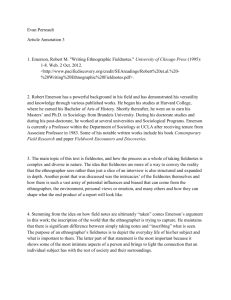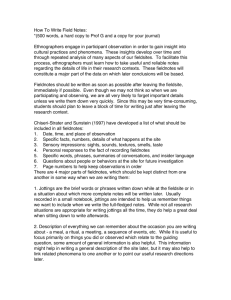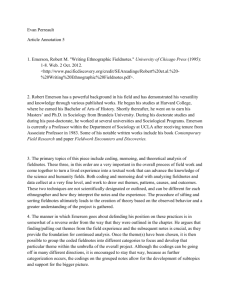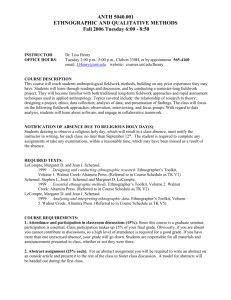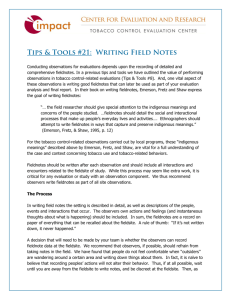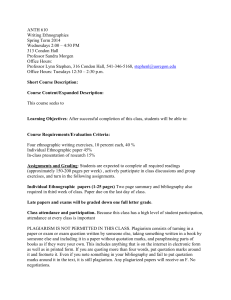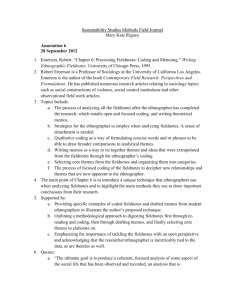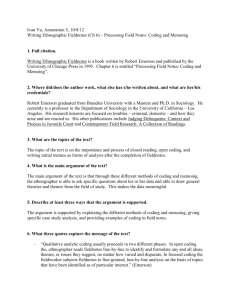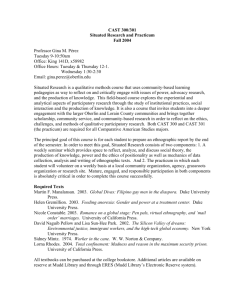Ethnographic Fieldnotes Summary: Emerson, Fretz, Shaw
advertisement
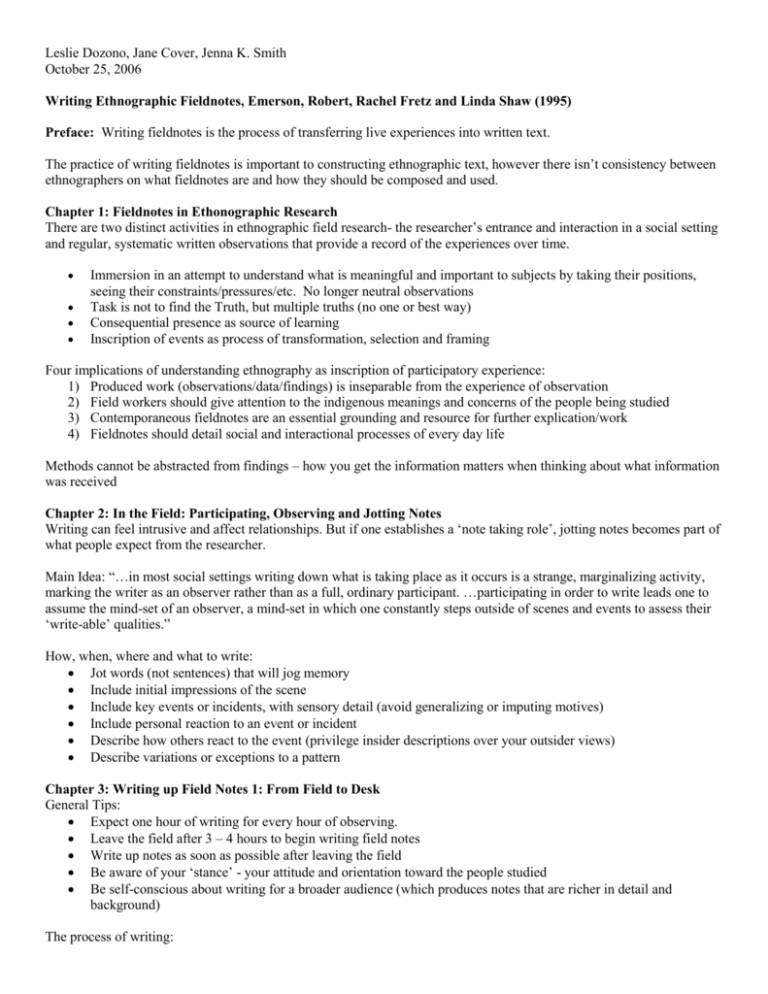
Leslie Dozono, Jane Cover, Jenna K. Smith October 25, 2006 Writing Ethnographic Fieldnotes, Emerson, Robert, Rachel Fretz and Linda Shaw (1995) Preface: Writing fieldnotes is the process of transferring live experiences into written text. The practice of writing fieldnotes is important to constructing ethnographic text, however there isn’t consistency between ethnographers on what fieldnotes are and how they should be composed and used. Chapter 1: Fieldnotes in Ethonographic Research There are two distinct activities in ethnographic field research- the researcher’s entrance and interaction in a social setting and regular, systematic written observations that provide a record of the experiences over time. Immersion in an attempt to understand what is meaningful and important to subjects by taking their positions, seeing their constraints/pressures/etc. No longer neutral observations Task is not to find the Truth, but multiple truths (no one or best way) Consequential presence as source of learning Inscription of events as process of transformation, selection and framing Four implications of understanding ethnography as inscription of participatory experience: 1) Produced work (observations/data/findings) is inseparable from the experience of observation 2) Field workers should give attention to the indigenous meanings and concerns of the people being studied 3) Contemporaneous fieldnotes are an essential grounding and resource for further explication/work 4) Fieldnotes should detail social and interactional processes of every day life Methods cannot be abstracted from findings – how you get the information matters when thinking about what information was received Chapter 2: In the Field: Participating, Observing and Jotting Notes Writing can feel intrusive and affect relationships. But if one establishes a ‘note taking role’, jotting notes becomes part of what people expect from the researcher. Main Idea: “…in most social settings writing down what is taking place as it occurs is a strange, marginalizing activity, marking the writer as an observer rather than as a full, ordinary participant. …participating in order to write leads one to assume the mind-set of an observer, a mind-set in which one constantly steps outside of scenes and events to assess their ‘write-able’ qualities.” How, when, where and what to write: Jot words (not sentences) that will jog memory Include initial impressions of the scene Include key events or incidents, with sensory detail (avoid generalizing or imputing motives) Include personal reaction to an event or incident Describe how others react to the event (privilege insider descriptions over your outsider views) Describe variations or exceptions to a pattern Chapter 3: Writing up Field Notes 1: From Field to Desk General Tips: Expect one hour of writing for every hour of observing. Leave the field after 3 – 4 hours to begin writing field notes Write up notes as soon as possible after leaving the field Be aware of your ‘stance’ - your attitude and orientation toward the people studied Be self-conscious about writing for a broader audience (which produces notes that are richer in detail and background) The process of writing: The goal is to get as much detail down and as quickly as possible, without evaluation and editing; Good examples of how to turn jottings into fieldnotes (pp. 49 – 51); Write in first person, third person, or combination (pp. 52 – 59); ‘Real time’ vs. ‘end point’ descriptions: real time characterizes events only in terms of what is known as the event unfolded; There is always more going on than what can be recorded; Too much reflection distracts and ‘paralyzes’; Chapter 4: Writing up Field Notes II: Creating Scenes on the Page 1. Depicting slices of observed & remembered life: Describing basic settings: concrete details, sensory imagery. Select details which most clearly and vividly create an image on the page. Presenting dialogue: Only put dialogue reported in verbatim between quotation marks. Other dialogue should be in indirect quotes or paraphrases. Characterizing main individuals: Characterizations should be created through writer’s ability to describe, report actions and present dialogue. Important to determine who is central vs. peripheral. 2. Organizing fieldnote descriptions: Sketches: Focus on all the senses for descriptions for snapshots of scenes. Episodes: Provide a description of a brief incident over time. Fieldnotes tales: Combining episodes in a way that describes situations over time, but also builds in suspense. 3. Strategies for analysis: Aides: Brief notes of analytic writing meant to provide a personal reflection for the writer. Provides a writer’s “lived sense” of a scene or interaction. Commentary: Typically written up as separate entries, convey writer’s record of their own experiences. Memos: Often completed after writing the day’s fieldnotes, inspired by those fieldnotes. Chapter 5: Pursuing Members’ Meanings Members’ meanings as interpretive constructions rather than truth discovery Possible issues with field researchers’ efforts: 1. Importing outside categories to describe members’ meanings and actions can obscure indigenous meaning 2. Present static taxonomies of native terms rather than situationally Moments that highlight expression, orientation and creation of local meaning: 1. Address and greeting – can reveal proper terms, relative status, local expectation 2. Every day questions and answers (questions & answers can reveal vital issues; orienting open-ended questions so that people can answer in familiar forms of expression) 3. Naturally occurring member descriptions – what do people say an activity or event “was about?” 4. Members’ stories not as factual accounts, but as situational (good to have diverse versions b/c can fill gaps) 5. Members’ terms, types and typologies (although should not assume single, discrete meanings) 6. Indigenous Contrasts – members’ describing things in terms of what they are not, which can signify what members’ see as significant differences 7. Members’ explanations and theories 8. Local events and social forces Gender, Race, & Class - Priority on how members’ deal with gender, race and class dynamics in different situations and contexts - Argues that researcher interested in these areas should choose work where it is particularly salient Researchers look for members’ own classifications, language, categories, etc, but must specify the conditions in which people invoke and apply such terms in interaction with others.

